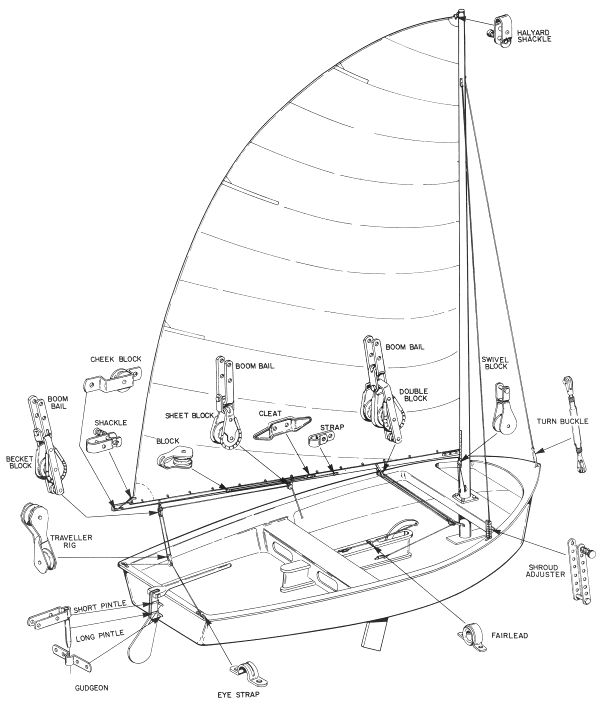

.....deck fittings
INTRODUCTION
"Deck fittings" is a general classification for all hardware used with the running or standing rigging, as well as the spars, even though the fittings may not always be mounted to the deck. Deck fittings may be located on cabin tops, cockpit members, and centerboard trunks as well. There are endless numbers and styles of fittings available, and the number of new fittings and inventions, plus modifications to existing ones, is constantly increasing. We will attempt to describe those which are most generally used in the size sailboats under discussion.
BLOCKS
A BLOCK is a wood, metal, or synthetic casing that contains one or more grooved pulleys called sheaves. Blocks are the primary pieces of equipment in the running rigging, and come in a wide variety of sizes and types. Besides adding mechanical advantage to the running rigging, blocks are used to change direction of the line passing through them. Conventional blocks must be attached to something in order to work, and the most common method used is by a shackle that is usually an integral part of the block. Three types of shackles are used; front, side, and swivel shackles. Fig. 6-1 shows the difference between front and side shackles, but the trend is to fit blocks with adjustable shackles which can be mounted either with a front or a side shackle using just one block or with a swivel shackle. A front or side shackle is used to keep the block in one position or plane of reference, whereas a swivel shackle allows the block to turn to any position.
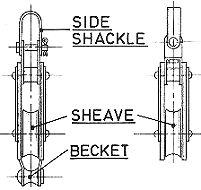 |
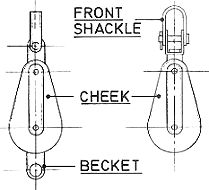 |
| FIG. 6-1 - The anatomy of blocks. Not all blocks have all of the above parts. Some blocks have shackles that swivel or are adjustable to either side or front shackle locations. A block with one sheave is a single block; with two sheaves a double block; etc. | |
|
FIG. 6-2 - This drawing shows hardware items and how they function on the boat. Note that all lines used to control various functions of the rig lead to a point convenient to the helmsman. |
A BECKET is often fitted to blocks at the opposite end of the shackle. The becket is a fitting on the block onto which a line with an eye, or another fitting such as a hook, can be attached, as in forming a tackle. Some of the common blocks are illustrated in Fig. 6-2.
A FIDDLE BLOCK as shown in Fig. 6-3 contains two sheaves, one above the other with one usually smaller in diameter than the other. It looks like a "fiddle." A fiddle block may have a becket as well as a cam cleat arrangement (see Fig. 6-4) for use with main sheets and boom vangs. A CHEEK BLOCK (see Fig. 6-2) lays flat to its base, with the base being fastened to the deck. The cheek block is commonly used to change direction of a line. SWIVEL DECK BLOCKS (Fig. 6-5) have a base which fastens to the deck and allows the block to assume a near-vertical position capable of swiveling in any direction. A BULLET BLOCK is a single block of small size which usually has no shackle (see Fig. 5-12). The top of the bullet block is usually shaped to attach through the eye of a line, an eye strap, or to a boom bail. A TRAVELER BLOCK is one with two sheaves, one above the other, and with one at right angles to the other (see Fig. 6-2). One sheave is for the traveler, and the other for the mainsheet. No shackle is used. Sometimes two bullet blocks interlocked at the straps can be made to form a traveler block.
When wire rope is used, blocks must be used which are intended for this material. Some blocks are available which have sheaves suitable for use with both rope and wire rope. The sheaves of these blocks have a regular groove for the rope, and a narrower but deeper groove within the regular groove to suit the wire rope.
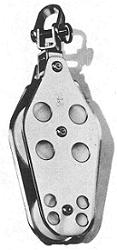
FIG. 6-3 - A typical example of a fiddle block. |
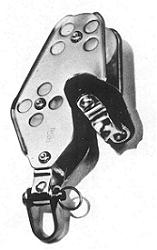
FIG. 6-4 - A fiddle block with a built-in cam cleat which can be used with various mainsheet and boom vang rigs. |
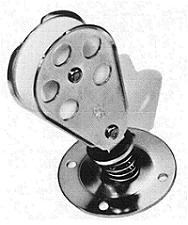
FIG. 6-5 - A swivel deck block allows the sheave to turn to the proper direction for the line leading through it. |
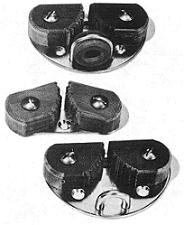
FIG. 6-6 - The cams of the cam cleat hold the line but it can be quickly released with a flick of the wrist. |
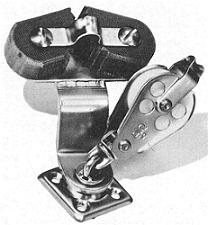 FIG. 6-7 - This is the deluxe mainsheet cam cleat which swivels, allows a fairlead to the main sheet and belays the line so it does not have to be hand held. photo courtesy Schaefer Marine Products |
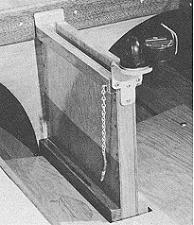 FIG. 6-8 - A swiveling mainsheet cam cleat mounted on a bracket on the daggerboard trunk. The mainsheet passes through the into the cam cleat. The looped wire (right) prevents the line from jumping out of the cleat when released. Note the pin on the daggerboard trunk to "lock" the daggerboard in position. |
CAM CLEATS
A CAM CLEAT is a fitting used to belay (halt and secure) a line. The line passes between two serrated cams which allow the line to be pulled through in only one direction. To release the line, it is pulled up and out of the cams. Fig. 6-6 shows a typical cam cleat. Cam cleats often have a fairlead to guide the line into the cams. Regular cam cleats are normally mounted flat to the deck. A cam cleat arrangement is often attached integrally to a fiddle block for adjusting a boom vang or main sheet. A deluxe fitting is a swiveling mainsheet cam cleat (Figs. 6-7 and 6-8) which comes with a block and a fairlead to change direction of the mainsheet, leading it into the cam cleat. The benefit of this fitting is that the helmsman need not hold onto the mainsheet, but it can he released in an instant by giving it a yank upwards. It also swivels so the sheet will be at hand on any tack.
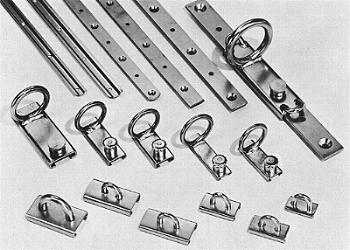 FIG. 6-9 - A selection of tracks and slides. Some are of stamped metal while others are extruded; aluminum, stainless steel, and plastics are common materials used. The slides shown are designed to fit the tracks. |
TRACKS
TRACKS are formed metal or plastic rails on which fittings can be attached to allow them to move. A piece of track is used where it is desirable to have the position of the fitting adjustable. Tracks can also be used to attach the sail to the spars in some cases. Tracks are commonly used for the jib and Genoa sheet leads which pass through fittings attached to slides moving on the tracks. These fittings can range from a fairlead slide, or a block on a slide, or even a cam cleat on a slide. Some typical slides and tracks are shown in Fig. 6-9. Tracks are also used for the clew outhaul slide and for sliding goosenecks. When the gooseneck mounts to a slide, a downhaul is used as well to allow for adjustment. Jib and Genoa tracks, and tracks used for travelers should be fitted with stops at the ends to prevent the fittings from sliding off the tracks. In selecting tracks, remember that the fitting to be used must be made to fit the type track being used.
CLEATS, FAIRLEADS, AND EYES
CLEATS (Fig. 3-19) are fittings to which lines are belayed and secured. With small sailboats, a common cleat is a JAM CLEAT. These allow a line to be taken through or turned around the jam cleat in such a manner so that it will not slip free. Jam cleats are commonly used to secure halyards and sheets. Many kinds of patented-type jam mechanisms are also available which are often referred to as "jam cleats" because they perform the same function.
FAIRLEADS are actually any fittings which give a "fair lead" to any line (see Fig. 6-2). Fairleads are usually eye-shaped fittings which minimize or prevent chafing of the line which passes through it. Fair fairlead (left) and leads usually change the direction of the line passing through them as well. As noted previously, a block can be used to change the direction of a line also, thereby making it a type of "fairlead" too. Fairleads can be fixed to the deck, swiveling, or mounted on tracks.
EYES such as PAD EYES, DEAD EYES, and EYE STRAPS are used to secure a line or a fitting to the boat (see Fig. 6-2). Many types are available to fulfill a variety of functions. Pad eyes, when fitted with a shackle, can secure a block to the hull and allow it to adopt the right position for proper sheet lead. Deadeye straps are often used to secure a traveler line or mainsheet to the hull. The traveler or mainsheet is knotted to prevent it from coming through the eyes.
WINCHES
Some comments on winches have been made previously. The variety and type of winches available to the sailor is enormous, but for the small boat sailor, winches usually are restricted to the smaller sizes used to control the jib and Genoa sheets. Winches can be used for the halyards, boom vang, and mainsheets, if desired. On small boats the cost is usually prohibitive, and the extra power gained is not required, as these lines can be handled by the crew or by other means, such as tackles, equally well.
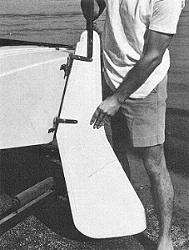
FIG. 6-10 - The rudder is connected to the boat with gudgeons (the fittings on the boat) and pintles (the pin fittings on the rudder). They allow the rudder to swing freely in order to steer the boat |
RUDDER FITTINGS
Small sailboats usually have rudders which are called "outboard" rudders because they hang onto the aft end of the boat in full view. Boats which have rudders under the hull and the rudder stock passing through the hull bottom are said to have "inboard" rudders, but these are usually associated with large boats. The ordinary small boat rudder is attached to the boat with fittings that also allow the rudder to pivot or turn. These fittings are called GUDGEONS and PINTLES. These are arranged in pairs, with the gudgeons usually being attached to the boat, and the pintles fastened to the rudder. The pintles are strap-like fittings with the rudder fitting between the straps, and with a pin at the forward edge which fits into the "eye" of the gudgeons (see Fig. 6-10). As with most fittings, many sizes and types are available. Often gudgeons and pintles come in pairs which have a long pintle and a shorter one. These types make it easier to put the rudder on the boat, as the long pintle will be in position first, thereby acting as a guide for the short one. If both pintles are the same length, both must fit into the gudgeons at the same moment, which is frustrating at times, especially when trying to place the rudder in position when afloat. Because many small boat rudders are made of wood, the tendency is for these to float up and out of the gudgeons, of course, making for an immediate loss of steering and much embarrassment. A device called a RUDDER STOP can be used to prevent this from occuring. These are standard marine hardware items very simple in nature.
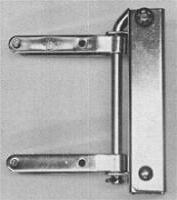 |
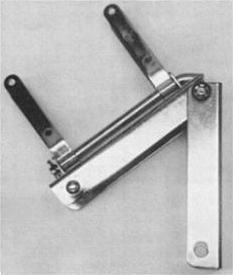 |
|
FIG. 6-11 - This special factory-made kick-up rudder fitting incorporates the rudder gudgeons and pintles. The fitting mounts to the transom of the boat but allows the rudder to be removed. This fitting is normally used on small boats only. |
|
For small sailboats which land on the beach, it is desirable to have the rudder "kick up" when approaching shallow waters. Special "kick-up" rudder fittings such as shown in Fig. 6-11 are available, which also have the gudgeons and pintles attached as an integral unit, and perform this function. With a little effort, you can make your own "kick-up" rudder similar to the detail shown in Fig. 6-12.
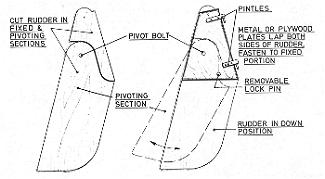
FIG. 6-12 - One method of making a kick-up rudder using wood. When the pin is removed, the rudder will automatically come up when hitting the beach. |
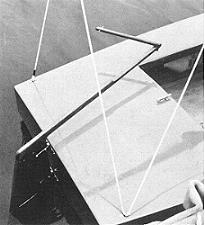 |
FIG. 6-13 - This tiller extension was made by merely cutting the tiller in half at the forward end and fastening it with a bolt. A more convenient type uses a swivel connection in lieu of the bolt for universal action. The line shown is a rope traveler which can be adjusted in length and is secured to the jam cleat on the deck. |
The rudder is controlled by a handle called the TILLER. Sometimes the tiller passes through a hole in the transom (back of the boat), but usually it is located above the aft deck area and pivots up and down so the crew can move about easily. The length of the tiller is best determined in actual use, so it should be made longer than necessary. It's much easier to cut off a long tiller than to add length to a short one. A device recommended for easier control, especially when tacking or sailing to windward, is a TILLER EXTENSION or "hiking stick," an example of which is shown in Fig. 6-13. When sailing to windward in a small boat, the boat usually heels considerably and the crew must lean out to windward (or "hike out") to counteract this. In order to hang onto the tiller in this position, an extension is required, fixed to the forward end of the tiller and preferably fitted with a universal-type joint. Naturally, the length of such a unit is best determined in actual use, so it is best to get a long one which can be cut, instead of getting one too short which can't be added to.
